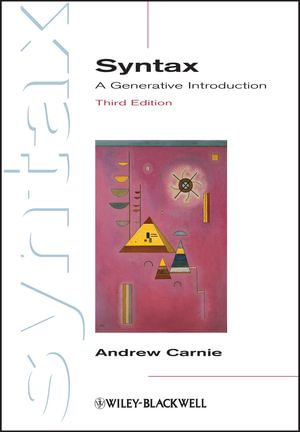
At a Glance
544 Pages
eBook
$74.99
or 4 interest-free payments of $18.75 with
orInstant Digital Delivery to your Kobo Reader App
- Supported by expanded online student and instructor resources, including extra chapters on HPSG, LFG and time-saving materials for lecturers, including problem sets, PowerPoint slides, and an instructors' manual
- Features new chapters on ellipsis, auxiliaries, and non-configurational languages
- Covers topics including phrase structure, the lexicon, Case theory, movement, covert movement, locality conditions, VP shells, and control
- Accompanied by a new optional workbook, available separately, of sample problem sets which are designed to give students greater experience of analyzing syntactic structure
on
Preface and Acknowledgments xiii
Part 1 Preliminaries 1
1 Generative Grammar 3
0. Preliminaries 3
1. Syntax as a Cognitive Science 5
2. Modeling Syntax 6
3. Syntax as Science - the Scientific Method 7
4. Where Do the Rules Come From? 18
5. Choosing among Theories about Syntax 29
6. The Scientific Method and the Structure of this Textbook 29
7. Conclusion 31
Ideas, Rules, and Constraints Introduced in this Chapter 31
General Problem Sets 33
Challenge Problem Sets 36
2 Parts of Speech 43
0. Words and Why They Matter to Syntax 44
1. Determining Part of Speech 45
2. The Major Parts of Speech: N, V, Adj, and Adv 48
3. Open vs. Closed; Lexical vs. Functional 51
4. Subcategories and Features 54
5. Conclusion 61
Ideas, Rules, and Constraints Introduced in this Chapter 61
General Problem Sets 62
Challenge Problem Sets 66
3 Constituency, Trees, and Rules 71
0. Introduction 71
1. Rules and Trees 74
2. How to Draw a Tree 90
3. Modification and Ambiguity 96
4. Constituency Tests 98
5. Constituency in Other Languages 100
6. Summary and Conclusion 106
Ideas, Rules, and Constraints Introduced in this Chapter 106
General Problem Sets 107
Challenge Problem Sets 114
4 Structural Relations 117
0. Introduction 117
1. The Parts of a Tree 118
2. Domination 120
3. Precedence 125
4. C-command 127
5. Grammatical Relations 132
6. Summary and Conclusions 135
Ideas, Rules, and Constraints Introduced in this Chapter 135
General Problem Sets 137
Challenge Problem Sets 144
5 Binding Theory 147
0. Introduction 147
1. The Notions Coindex and Antecedent 149
2. Binding 151
3. Locality Conditions on the Binding of Anaphors 153
4. The Distribution of Pronouns 155
5. The Distribution of R-expressions 156
6. Conclusion 156
Ideas, Rules, and Constraints Introduced in this Chapter 157
General Problem Sets 158
Challenge Problem Sets 159
Part 2 The Base 163
6 X-bar Theory 165
0. Introduction 165
1. Bar-level Projections 167
2. Generalizing the Rules: The X-bar Schema 172
3. Complements, Adjuncts, and Specifiers 175
4. Some Definitional Housekeeping 185
5. Parameters of Word Order 186
6. Drawing Trees in X-bar Notation 189
7. X-bar Theory: A Summary 198
Ideas, Rules, and Constraints Introduced in this Chapter 199
General Problem Sets 200
Challenge Problem Sets 204
7 Extending X-bar Theory to Functional Categories 207
0. Introduction 207
1. Determiner Phrases (DPs) 208
2. A Descriptive Tangent into Clause Types 211
3. Complementizer Phrases (CPs) 216
4. Tense Phrases (TPs) 219
Ideas, Rules, and Constraints Introduced in this Chapter 221
General Problem Sets 222
Challenge Problem Sets 224
8 Constraining X-bar: Theta Theory 227
0. Introduction 227
1. Some Basic Terminology 228
2. Thematic Relations and Theta Roles 229
3. The Lexicon 236
4. Expletives and the Extended Projection Principle 237
5. Conclusion 239
Ideas, Rules, and Constraints Introduced in this Chapter 240
General Problem Sets 241
Challenge Problem Sets 245
9 Auxiliaries and Functional Categories 249
0. Introduction 250
1. Complementizers 250
2. Determiners 254
3. Understanding Tense, Aspect, Voice, and Mood 258
4. Auxiliaries 263
5. Conclusion 278
Ideas, Rules, and Constraints Introduced in this Chapter 279
General Problem Sets 281
Challenge Problem Sets 284
Part 3 Movement 287
10 Head-to-Head Movement 289
0. Introduction 289
1. Verb Movement (V ? T) 292
2. T Movement (T ? C) 308
3. Do-support 311
Ideas, Rules, and Constraints Introduced in this Chapter 312
General Problem Sets 313
Challenge Problem Sets 318
11 DP Movement 323
0. Introduction 323
1. A Puzzle for the Theory of Theta Roles 324
2. Passives 330
3. Case 335
4. Raising: Reprise 339
5. Passives: Reprise 342
6. Tying Up a Loose End 344
7. Conclusion 346
Ideas, Rules, and Constraints Introduced in this Chapter 346
General Problem Sets 347
Challenge Problem Sets 352
12 Wh-movement and Locality Constraints 357
0. Introduction 357
1. Movement in Wh-questions 359
2. Relative Clauses 369
3. Islands 374
4. The Minimal Link Condition 377
5. Echo Questions (Wh-in-situ) in English 382
6. Conclusion 383
Ideas, Rules, and Constraints Introduced in this Chapter 384
General Problem Sets 385
Challenge Problem Sets 387
13 A Unified Theory of Movement 391
0. Introduction 391
1. Move 393
2. Explaining Cross-linguistic Differences 396
3. Scope, Covert Movement, and the MLC 401
4. Conclusion 405
Ideas, Rules, and Constraints Introduced in this Chapter 405
General Problem Sets 406
Challenge Problem Sets 406
Part 4 Advanced Topics 409
14 Expanded VPs 411
0. Introduction 411
1. The Problem of Ditransitive Verbs 412
2. The Active Voice Head and Other Light Verbs 413
3. Object Shift 416
4. Ditransitives: Reprise 421
Ideas, Rules, and Constraints Introduced in this Chapter 425
General Problem Sets 425
Challenge Problem Sets 427
15 Raising, Control, and Empty Categories 429
0. Introduction 430
1. Raising vs. Control 431
2. Two Kinds of Raising, Two Kinds of Control 439
3. Control Theory 445
4. Another Kind of Null Subject: "Little" pro 449
5. Conclusion 450
Ideas, Rules, and Constraints Introduced in this Chapter 451
General Problem Sets 452
Challenge Problem Sets 454
16 Ellipsis 457
0. Ellipsis 457
1. LF-copying or PF-deletion 460
2. Antecedent-Contained Deletion and Pseudogapping 466
3. Conclusion 470
Ideas, Rules, and Constraints Introduced in this Chapter 471
General Problem Sets 472
Challenge Problem Sets 475
17 Advanced Topics in Binding Theory 477
0. Introduction 477
1. Levels of Representation 478
2. The Definition of Binding Domain 480
Ideas, Rules, and Constraints Introduced in this Chapter 486
General Problem Sets 487
Challenge Problem Sets 489
18 Polysynthesis, Incorporation, and Non-configurationality 491
0. Introduction 491
1. Polysynthesis 492
2. Incorporation 494
3. Scrambling and Non-configurationality 496
4. Conclusions 505
Ideas, Rules, and Constraints Introduced in this Chapter 505
General Problem Sets 506
Challenge Problem Sets 507
Conclusions and Directions for Further Study 509
References 511
Index 519
ISBN: 9781118321874
ISBN-10: 1118321871
Series: Introducing Linguistics : Book 18
Published: 20th August 2012
Format: ePUB
Language: English
Number of Pages: 544
Audience: Professional and Scholarly
Publisher: Wiley
Country of Publication: US
Volume Number: 18
Edition Number: 3
You Can Find This eBook In

eBOOK
RRP $33.99
$27.99
OFF

eBOOK
RRP $25.99
$20.99
OFF

eBOOK
RRP $26.99
$21.99
OFF

eBOOK
RRP $24.99
$20.99
OFF

eBOOK
RRP $35.99
$28.99
OFF

eBOOK
RRP $25.99
$20.99
OFF

eBOOK
eBook
$9.99

eBOOK
RRP $60.29
$54.99

eBOOK
RRP $33.97
$28.99
OFF

eBOOK
RRP $192.95
$164.99
OFF

eBOOK
RRP $32.95
$28.99
OFF

eBOOK
RRP $250.95
$213.99
OFF

eBOOK
RRP $25.99
$20.99
OFF

eTEXT
$89.75










